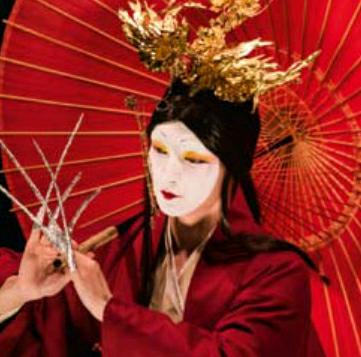The Tea Spell:A Modern Expression of Chinese Contemporary Dance
by+Gong+Haiying
On September 2, the aroma of hot tea swept through 300-year-old Zhengyici Peking Opera Theatre as the audience settled in for the show. A female dancer in white sipped tea and took questions from spectators. Contrasting most opera stages with a strict proscenium, the stage of Zhengyici Peking Opera Theatre thrusts far out into the auditorium. The tea ceremony took place in the VIP seats. Zhao Liang, a Chinese contemporary dance artist and direc- tor of the opera, introduced that the performance kicked off as the tea ceremony began. Then, seven dancers leaped and moved across the stage of the scarlet theater, so close to the audience that the first row caught beads of their sweat. The stage was designed by Zhang Liang, who believes that good art should be expressive from multiple dimensions and that future art will focus more on “integrity” and feature greater interaction with the audience.
The Tea Spell is the second part of the trilogy Oriental Soul & Desire and was first performed in 2012. The first installment, Dreams of Zen, was first performed in 2011, the third in 2015. This opera focused on Chinas culture of Zen and tea and was inspired by a delicate tea set unearthed from an underground palace of Tang Dynasty that is considered the oldest and largest surviving underground Buddhist palace.
The opera is performed with tea as a driving symbol. The beautiful female“Teafairy,” played by a man, meets three people: a wood cutter, a dignitary, and a monk. Those three people have differ- ent ideas when meeting the heroine. The choreography is concise. The makeup, costume and dance steps of The Tea Spell were inspired by traditional Chinese opera including Kunqu Opera and Beijing Opera. Every frame presents a Chinese style freehand brushwork painting. The performance was hailed for “creating an ‘ancient Orientin modern times.”
Huang Yinran, a renowned Chinese art planner and poet, said that Zen and tea are the two elements that represent profound traditional Chinese culture through two important dimensions. The Tea Spell was intended to promote traditional Chinese cul- ture from the day of its inception. However, the opera became much more. The wood cutter, dignitary and monk, in fact, represent three types of people, each representing various levels of identity, ego, and superego in times past. The opera is hailed as a “pioneering mixture of Oriental aesthetics and western narrative.”
After its first show in Beijing on October 31, 2012, The Tea Spell was recommended by Chinas Ministry of Culture to be performed in the Chinese cultural year in Germany in early November that year. The opera group has since visited Seoul and the Edinburgh International Festival. The opera was invited to perform in the Suzanne Dallal Centre for Dance and Theatre in Israel in October this year.
Zhao Liang remarked that The Tea Spell is not confined to the limits of a room. “It is what art should be represented as in a free state,” he argued. “In the future, I will present different versions and forms based on the architecture of the performance space.” Zhao Liang has paved a unique road to explore the modern expression of Chinese dance, which has created countless new avenues for expression.endprint
- China Pictorial的其它文章
- Xi Jinping in Zhengding:Innovating Economic Development
- Xi Jinpingin Fujian:Great Care and Pragmatic Reform for the People
- Xi Jinpingin Zhejiang:Taking the Lead through Solid Work
- Xi Jinpingin Shanghai:Targeting Long-term Development and Defining Direction
- Feng Cuiling:A Breath of Fresh Air
- Su Wenzhu: Reading Yesterday Today

